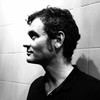Me wearing a headset. All photos by the author, even if the author clearly didn't take this one.
Advertisement
Advertisement
Pieter Rossouw, clinic manager
The view from within the goggles. Of course, these two images conjoin to create one 3D image.
Advertisement
While Pieter controlled the spider, I tried batting it. Very Black Mirror
The boss level: hold the spider
